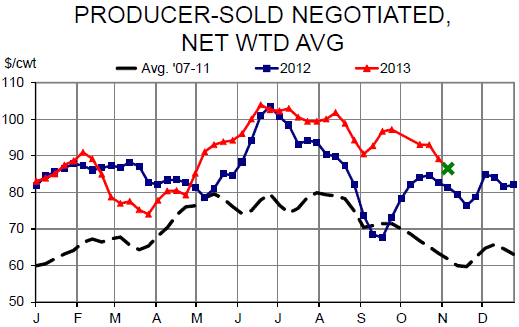



CME: Hog Numbers Increasing; Rapid Increase Likely in Weeks to Come
US - Are we returning to a more normal market hog flow? We suppose that question in an of itself says that the flow we have seen has been abnormal so let’s consider the situation this fall, what it may mean and what may come in the next few weeks, write Steve Meyer and Len Steiner.- Yesterday’s estimated FI hog slaughter was 438,000 head, the largest day so far this year. That follows runs of 434k and 436k on Monday and Tuesday. The three-day total is the largest of the year as well, suggesting that we are finally finding some of the hogs USDA said were out there. But the year-on-year change from 2012 for these 3 weeks is still only +0.6 per cent at a time when the September report said 1.5 per cent more hogs should be available.
- The lower-than-expected numbers do coincide with a time period in 2012 when producers were aggressively reducing hog numbers to avoid buying high-priced feed. Feed costs soared in July last year and there was significant breeding herd liquidation, especially among smaller producers. Now "smaller" producers these days still may have held several hundred or even a few thousand sows so their exit from the industry would leave a hole — 12 months later. It more and more appears that this factor was larger than USDA picked up in breeding herd numbers last year and pig crop numbers last spring. Dow McVean of McVean Trading in Memphis calls it "creeping liquidation" that was underestimated. The data more and more support the idea.
- Packer gross margins have not been conducive to aggressive throughput at plants. As can be seen below, gross margins this year were far lower than the 5-year average from July through early September. It’s easy to see why packers did not push numbers when they simply weren’t making much money. The situation has improved some in recent weeks.

- A major driver of the improved margin picture for pork packers has simply been the reduction in hog prices —quite normal for this time of year. The last observation in the chart below (green X) is the average for Monday and Tuesday. If that average holds for the week (and it may well be high as yesterday’s afternoon purchase price was down 0.41/cwt from Tuesday), the decline since September 27 would be $10.67/cwt. That compares to a 5- year average decline of $9.68/cwt. for the period.

- This year’s price path, however, is different due to the sharp rally in September that very well could have encouraged producers to slow their marketings. Why get in a hurry to sell pigs that are eating much less pricey feed, gaining well in cooler weather and with great-tasting (at least to a pig!) fresh corn and won’t be worth much less per pound next week? Price breaks in the past two weeks may have changed that, of course.
- We need to remember that daily slaughter is important but weekly slaughter is another matter since Saturday is such a huge "swing day". US pork packing capacity is estimated to be 444,320 head per day. Plants could push a few more if hogs were more plentiful and margins were good but the fill day is Saturday and those runs have been very small versus normal and last year. Last week’s Saturday total was 117,000. That was the fourth straight week of over 100,000 but those four weeks a year ago saw over 210,000 head on Saturday each week. We expect this week’s Saturday total to be larger but it still small by historical standards.
The bottom line is that hog numbers are increasing and will likely increase more rapidly in the next few weeks but will likely remain below levels suggested by the September report and will not fill the "hole" created in the past two months.








